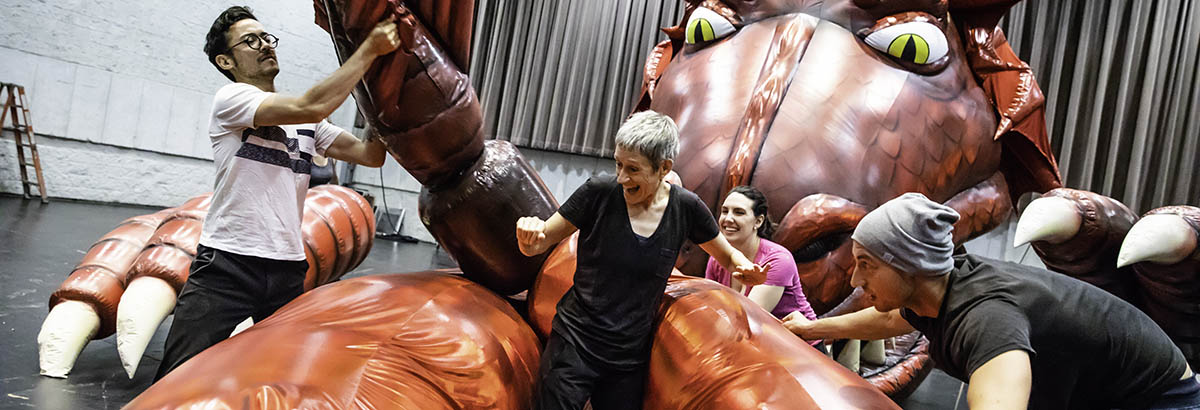April 09, 2020
Choreographing the RING
How does one differentiate the physical vocabulary of different types of beings in Lyric’s Ring? “A lot of that comes from the physicality of the singer singing the role,” says British choreographer Denni Sayers, “and working with our movement crew – a mix of acrobats, stage combat artists, puppeteers, and aerialists. Sometimes they’re doing really hard physical labor, and then they suddenly become the oppressed Nibelungen working in the mine. They adapt their movement depending on where they are in the story.”
For the Rhinemaidens, “there are two jobs: one with the traffic flow with the camera dollies and working out what effects that can create; and the other to get the Rhinemaidens to move on those camera dollies so they aren’t just being wheeled around but are characters as well. We have to continue that physicality when they come down off the dollies, so they don’t become a different character.” In Rheingold there are large pieces of equipment to be manipulated, “but it’s still an incredibly human scale of storytelling.”
As for the warrior maidens in Die Walküre, “their scene involves the singers and the movement crew, some of whom are dressed as what we call the ‘mortuary attendants,’ dealing with the dead bodies. We also have three horses; the singers stand up in the stirrups, they lean forward, lean back, interact with each other. When they’re singing, we make sure they’re in a position where they can see the conductor or the monitor.”
With the young hero of Siegfried, “Burkhard Fritz’s costume and wig really help, and his being surrounded by giant-sized scenery. Playing someone bullish, curious, and selfish defines his physicality, and it’s filled by his approach to Siegfried’s psychology – a child brought up without being taught any manners or social niceties.”

With both Siegfried and Mime, “it’s important that they never look like they’re doing something because it’s been choreographed – it’s just how the person would move.” Everything onstage in Siegfried’s Act One is “giant-sized, including the anvil, which was like a big child’s DIY toy. In the forest, members of the crew carry big green panels and surround Siegfried with them. The forest is meant to be magical. If you want someone to move through a forest, there’s a limit to what you can do onstage unless you use back projections. In this case, we made the forest journey around Siegfried.”
One of Siegfried’s major challenges is Erda, “half submerged and in a dress built out into a vast skirt that the crew manipulates around her, so that that it’s constantly flowing and responding to the music. Because she’s wearing that huge dress, she must anchor herself so that she doesn’t get pulled off. She’s on a platform and has to support her own balance.”
Interviewed prior to Götterdämmerung rehearsals, Sayers anticipated that the production would be “very futuristic, with an almost dictatorial, fascistic element to the Gibichungs’ world. Certainly women are very subservient in it, and there will be a sense of people treated almost like automatons – but of course, we will go back to the Rhine for the finale!”
In addition to Das Rheingold (2016/17), Die Walküre (2017/18), and Siegfried (2018/29), renowned British choreographer and director Denni Sayers’s work has been seen in five other operas at Lyric since 2000|01, most recently The Magic Flute (2017|18).
Edited from interviews with Roger Pines, Dramaturg, Lyric Opera of Chicago. This article was written for publication in the Ring cycle program, 2019/20 season.
